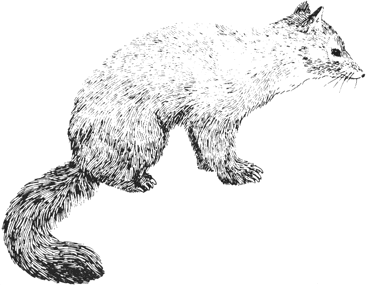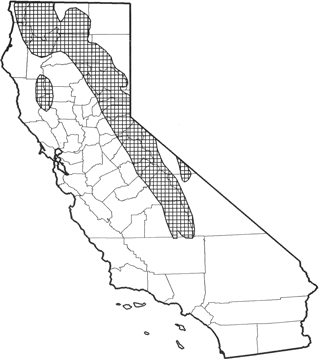
American Marten
Distribution, Abundance, and Seasonality
Uncommon to common, permanent resident of North Coast regions and Sierra Nevada, Klamath, and Cascades Mts. Optimal habitats are various mixed evergreen forests with more than 40% crown closure, with large trees and snags. Important habitats include red fir, lodgepole pine, subalpine conifer, mixed conifer, Jeffrey pine, and eastside pine (Grinnell et al. 1937, Schemof and White 1977, Clark et al. 1987).

Range Map
Specific Habitat Requirements
Feeding: American martens are mostly carnivorous, taking primarily small mammals: tree squirrels, chipmunks, mice, shrews, rabbits, hares, and pikas. Spring through autumn, often eat birds, insects, and fruits. Eat fish, and will forage along edge of water (Haley 1975). Forage on ground, and in trees, snags, logs, and rock areas. May tunnel under snow. Search and pounce on, or chase prey. Use forepaws to remove birds from tree cavities. Individuals may travel up to 24 km (15 mi) hunting in 1 night.
Cover: Use cavities in large trees, snags, stumps, logs, or burrows, caves, and crevices in rocky areas for denning cover. Less commonly will den in woodpiles, cabins, and other human artifacts. Also may den under snow near logs, stumps, or other objects.
Reproduction: Nests are located in cavities, as described above, lined with leaves, grass, mosses, or other vegetation.
Water: No information found.
Pattern: Habitat with limited human use is important. Martens require a variety of different-aged stands, particularly old-growth conifers and snags, which provide abundant cavities for denning and nesting. Tend to travel along ridgetops, and rarely move across large areas devoid of canopy cover. Small clearings, meadows, and riparian areas provide foraging habitats, particularly during snow-free periods. Little information available on the interspersion of habitats required by this species.
Species Life History
Activity Patterns: Active yearlong. Mostly nocturnal and crepuscular, some diurnal activity.
Seasonal Movements / Migration: Non-migratory, although may move to lower elevations in winter.
Home Range: In Montana, home ranges of males averaged 238 ha (589 ac), and varied from 88-262 ha (218-646 ac). Home ranges of females averaged 70 ha (173 ac), and varied from 8-52 ha (19-128 ac) (Hawley and Newby 1957). Home ranges often coincide with topographical or vegetation features, such as timber stands, ridges, streams, meadows, or burns.
Territory: Territory may equal home range; antisocial behavior between males observed within a male's home range. In contrast, males and females tolerant of each other, and adults tolerant of juveniles, in other observations.
Reproduction: Breed in summer; have a gestation of 220-290 days, including delayed implantation (Maser et al. 1981). Embryos usually implanted in uterus during February, having an active growing period of about 27 days prior to birth. Most litters born in March and April, some as late as June. One litter/yr of an average 3.5 young, ranging from 1-5. Young stay with female until autumn, and then begin solitary life. Males are mature sexually at 1 yr, females at 2 yr.
Niche: Occasionally prey of fishers, bobcats, great horned owls, and eagles (deVos 1952). Agile climbers, and mostly arboreal. Population levels appear to follow primary prey abundance. Sensitive to human disturbance, and trapped easily. Large clearcuts, extensive even-aged forest management, and destruction of mature stands are detrimental to these mustelids. Potentially compete with other carnivorous forest-dwelling mammals and birds, such as fishers, bobcats, spotted owls, great horned owls, and accipiters. Competition for den sites may occur with other cavity using species.
Sources & References
California Department of Fish and Game, 1999.
California's Wildlife, Sacramento, CA.
Written by: G. Ahlborn, reviewed by: M. White, edited by: M. White
Clark, T. W., E. Anderson, C. Douglas, and M. Strickland. 1987. Martes americana. Mammal. Species No. 289. 8pp. deVos, A. 1952. The ecology and management of fisher and marten in Ontario. Ont. Dep. Lands and Forests. Tech. Bull., Wildl. Ser. 1. 90pp. Grinnell, J., J. S. Dixon, and J. M. Linsdale. 1937. Fur-bearing mammals of California. 2 Vols. Univ. California Press, Berkeley. 777pp. Haley, D. 1975. Sleek and savage: North America's weasel family. Pacific Search Books, Seattle, WA. 128pp. Hawley, V. D., and F. E. Newby. 1957. Marten home ranges and population fluctuations. J. Mammal. 38:174-184. Maser, C., B. R. Mate, J. F. Franklin, and C. T. Dyrness. 1981. Natural history of Oregon coast mammals. Pac. Northwest For. And Range Exp. Sta., USDA, For. Serv., Gen. Tech. Rep., PNW-133. 496pp. Newberry, D. W. 1973a. A contribution towards a bibliography of California furbearers. Calif. Dept. Fish and Game, Spec. Wildl. Invest., Sacramento. 148pp. Newberry, D. W. 1973b. Marten field transect study, Tahoe Basin, California. Calif. Dep. Fish and Game. Spec. Wildl. Invest., Sacramento. 9pp. Schempf, P. F., and M. White. 1974. A survey of the status of seven species of carnivores on National Park Service lands in California. Dep. For. And Conserv., Univ. Calif., Berkeley. 129pp. Schempf, P. F., and M. White. 1977. Status of six furbearer populations in the mountains of northern California. U.S. Dep. Agric., For. Serv., San Francisco, Calif. 51pp. Simon, T. L. 1980. An ecological study of the marten in the Tahoe National Forest, California. M.S. Thesis, Sacramento State Univ. 187pp. Soutiere, E. C. 1979. Effects of timber harvesting on marten in Maine. J. Wildl. Manage. 43:850-860. Weckwerth, R. P., and V. D. Hawley. 1962. Marten food habits and population fluctuations in Montana. J. Wildl. Manage. 26:55-74.
California Animal Facts | California's Wildlife